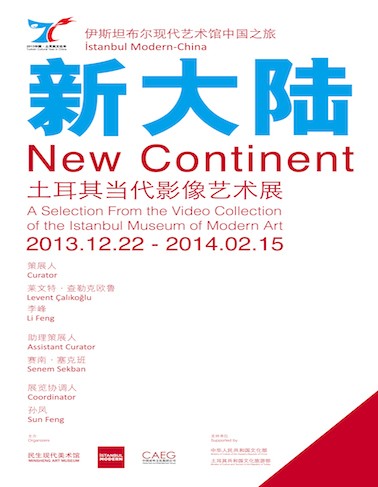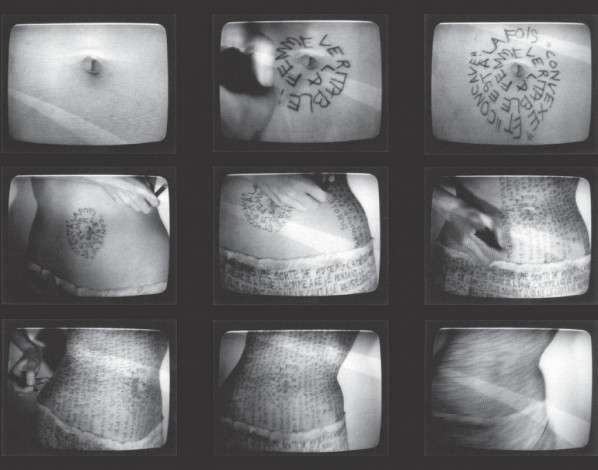
As a highlight of the Year of Turkish Culture in China 2013, New Continent – A Selection from the Video Collection of the Istanbul Museum of Modern Art will be unveiled at Shanghai Minsheng Art Museum on December 22, 2013. Gathering together 7 works by 6 artists from different periods, the exhibition focuses on contemporary themes such as imagination, identity, the body and the social-political discourses surrounding it, promises of a happy future, the nature of visual culture, and the sanctification of life. The exhibition in China is the latest one in a series of shows that İstanbul Modern has held in major cities since 2009.
While describing Istanbul as a “new continent” at the center of the contemporary art world, the exhibition scrutinizes the dynamics of transformation and changes that have taken place in contemporary Turkish art from the 1970s to the present day. It was as if they’d discovered a new continent, when the global world of art and culture found Istanbul in the 2000s. The contemporary, mainly European view of this region, which dates back thousands of years, is that its vital and dynamic enough to justify every sort of “post” prefix. From its nightlife to its street life, from its museums to its alternative artist collectives, Istanbul is living through a period in which culture and tourism mingle and intertwine. As in the last days of the Ottoman Empire, Istanbul is now a place where countless foreign artists set up studios and create new webs of relationships. Regarded by sociologists and cultural scholars as an “appetizing feast”, this city resembles a new continent where countless discourses co-exist and dance together.
But this change did not start in the 2000s.This artistic transformation began in the second half of the 1970s, emerging alongside the culture of excessive consumption created by the free market economy which came into being after the military coup of 1980; a coup, by the way, which the transformation in question treated critically and indeed rejected. This transformation was affected by the shock waves that formed with the fall of the Berlin Wall, that symbol of the cultural and political contradictions between East and West. The pluralistic and democratic nature of the exhibitions nourished this transformation. Providing a setting for diverse cultural experiences, and undermining archetypal representations of nation-identity, this pluralistic phenomenon was at the same time affected by the vibrations of the new type of life and thinking which came in the wake of globalization. This movement not only created a fracture in the established order and all forms of relationship that represented it; it also generated a tension between what is “here and now” and the modernist tendencies rooted in the past.
The seven exhibits are selected the collection of Istanbul Museum of Modern Art and will be presented at the two galleries on the second floor of the museum. Being Turkey’s first private museum to organize modern and contemporary art exhibitions, Istanbul Museum of Modern Art boasts a wide range of collection. Western and Turkish aesthetic values meet here, making it the ideal bridge for the communication between contemporary art practice in Turkey and other parts of Europe. Varying significantly in age, the six participating artists bring Chinese audience a visual feast that features their distinctive personal approaches and insights. Nil Yalter created The Headless Woman or the Belly Dancein 1974: it was the first video exhibited in Turkey and is still regarded as a landmark in the history of the genre in France. Trained as a sculptor, Nil Yalter later studied under Marina Abramovic. Emotion in Motion, the work presented at New Continent, is a piece of performance art that was done in 2002. She used her body as a vehicle in her performances as a means of entering into a new kind of interaction with the viewers. She reflects social, political and cultural agendas in her art that also reference the particulars of the spaces in which they are contained; and in the meantime, manages to retain both their poetic and their aesthetic qualities.

The Headless Woman, or the Belly Dance 1974. Courtesy of Nil Yalter, for further information please visit http://www.nilyalter.com/
Turkey began to fully feel the effects of the pluralistic phenomenon in the 2000s, but its moment of birth was charged with serious internal contradictions and brought about a painful transformation. This transformation in the mutually interacting spheres of art, culture and politics, which glimmered into being toward the end of the 1980s and became apparent in the 1990s, still continues today. Many artists of today think and create has been changed by the climate of thought which arose from this process. Works put on display during the exhibition endeavor to shed light on the recent development of Turkish contemporary art.
To demonstrate the glorious long history and dynamic creativity of both countries, The Year of Chinese Culture in Turkey 2012 and The Year of Turkey in China 2013, jointly launched by Chinese and Turkish governments, are so far the biggest, longest, the most comprehensive and most high-profile cultural event series between the two countries since the establishment of diplomatic relations forty years ago. As a response to Transformation: A view on Chinese Contemporary Ar theld in Istanbul last year, New Continent – A Selection from the Video Collection of the Istanbul Museum of Modern Art offers audience in China a chance to get a glimpse of Turkish contemporary art, marking a new starting point for the two countries to further collaboration in the field of contemporary art.
Co-curated by Levent Calikoglu, chief curator at Istanbul Modern, and Li Feng, executive director of Minsheng Art Museum, the exhibition is made possible with collaboration of Sun Feng, project manager of the China Arts & Entertainment Group, and the great support from the Ministry of Culture of the People's Republic of China and Ministry of Culture and Tourism of the Republic of Turkey. A series of public and educational events will be presented following the opening. The exhibition will run through February 15, 2014.
About the exhibition
Duration: Dec 22, 2013 - Feb 15, 2014
Venue: Mingsheng Art Museum
Courtesy of the artists and Minsheng Art Museum, for further information please visit www.minshengart.com.




























